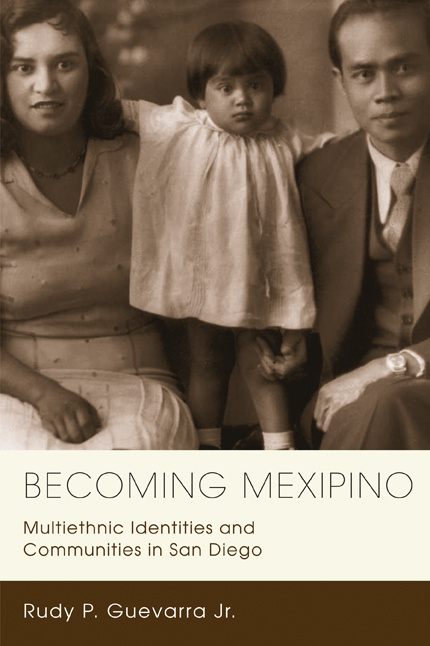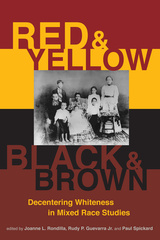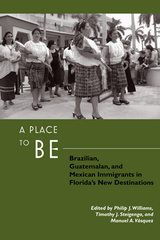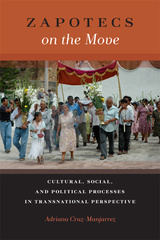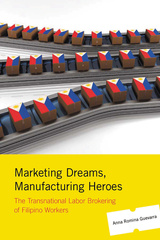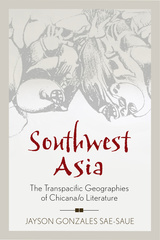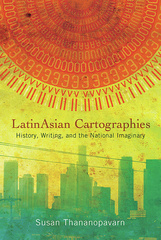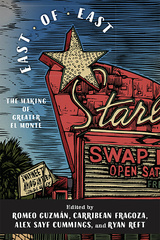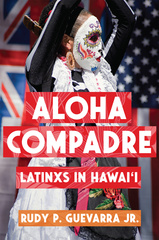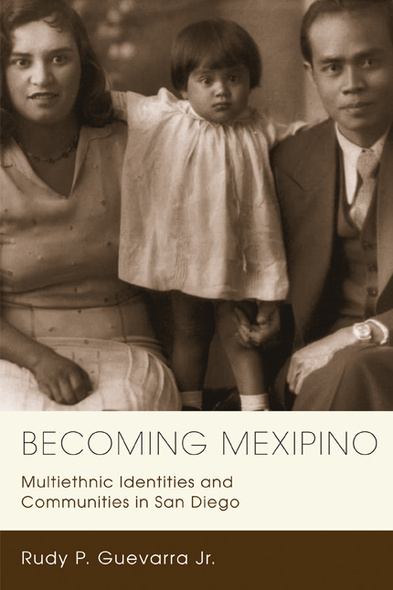
256 pages, 6 x 9
21 photographs, 3 maps, 5 tables
Paperback
Release Date:09 May 2012
ISBN:9780813552842
Hardcover
Release Date:09 May 2012
ISBN:9780813552835
Becoming Mexipino
Multiethnic Identities and Communities in San Diego
Rutgers University Press
Becoming Mexipino is a social-historical interpretation of two ethnic groups, one Mexican, the other Filipino, whose paths led both groups to San Diego, California. Rudy Guevarra traces the earliest interactions of both groups with Spanish colonialism to illustrate how these historical ties and cultural bonds laid the foundation for what would become close interethnic relationships and communities in twentieth-century San Diego as well as in other locales throughout California and the Pacific West Coast.
Through racially restrictive covenants and other forms of discrimination, both groups, regardless of their differences, were confined to segregated living spaces along with African Americans, other Asian groups, and a few European immigrant clusters. Within these urban multiracial spaces, Mexicans and Filipinos coalesced to build a world of their own through family and kin networks, shared cultural practices, social organizations, and music and other forms of entertainment. They occupied the same living spaces, attended the same Catholic churches, and worked together creating labor cultures that reinforced their ties, often fostering marriages. Mexipino children, living simultaneously in two cultures, have forged a new identity for themselves. Their lives are the lens through which these two communities are examined, revealing the ways in which Mexicans and Filipinos interacted over generations to produce this distinct and instructive multiethnic experience. Using archival sources, oral histories, newspapers, and personal collections and photographs, Guevarra defines the niche that this particular group carved out for itself.
Through racially restrictive covenants and other forms of discrimination, both groups, regardless of their differences, were confined to segregated living spaces along with African Americans, other Asian groups, and a few European immigrant clusters. Within these urban multiracial spaces, Mexicans and Filipinos coalesced to build a world of their own through family and kin networks, shared cultural practices, social organizations, and music and other forms of entertainment. They occupied the same living spaces, attended the same Catholic churches, and worked together creating labor cultures that reinforced their ties, often fostering marriages. Mexipino children, living simultaneously in two cultures, have forged a new identity for themselves. Their lives are the lens through which these two communities are examined, revealing the ways in which Mexicans and Filipinos interacted over generations to produce this distinct and instructive multiethnic experience. Using archival sources, oral histories, newspapers, and personal collections and photographs, Guevarra defines the niche that this particular group carved out for itself.
Guevarra’s fresh, exciting, and provocative analysis provides an extraordinary account of what it means to be a multiethnic American…a remarkable feat!
With a love for the archives and family stories, labor historian Rudy Guevarra provides a wonderfully rich, layered history of a vibrant multiethnic community in southern Califorinia.
An original and detailed account of the intimate, complex relationship between Mexicans and Filipinos in San Diego from 1903 to 1965, Becoming Mexipino is comparative ethnic studies at its best.
[A] fine book. One of the best histories of the San Diego region and a key title in Filipino American history. It advances the field of Chicana/o studies. Recommended.
Rudy Guevarra's personal passion in celebrating and maintaining Mexipino identity into the twenty-first century make Becoming Mexipino an engaging read.
Guevarra, a fourth-generation Mexipino from San Diego, makes major contributions to scholarship on the history of immigration to California and the history of San Diego as he tells the forgotten story of ethnic mixing of thousands of Filipinos and Mexicans.
Thoroughly researched and engagingly written, Becoming Mexipino contributes significantly to our understanding of identity and community formation by those whose color and culture drew them together across ethnic boundaries.
Guevarra’s fresh, exciting, and provocative analysis provides an extraordinary account of what it means to be a multiethnic American…a remarkable feat!
With a love for the archives and family stories, labor historian Rudy Guevarra provides a wonderfully rich, layered history of a vibrant multiethnic community in southern Califorinia.
An original and detailed account of the intimate, complex relationship between Mexicans and Filipinos in San Diego from 1903 to 1965, Becoming Mexipino is comparative ethnic studies at its best.
[A] fine book. One of the best histories of the San Diego region and a key title in Filipino American history. It advances the field of Chicana/o studies. Recommended.
Rudy Guevarra's personal passion in celebrating and maintaining Mexipino identity into the twenty-first century make Becoming Mexipino an engaging read.
Guevarra, a fourth-generation Mexipino from San Diego, makes major contributions to scholarship on the history of immigration to California and the history of San Diego as he tells the forgotten story of ethnic mixing of thousands of Filipinos and Mexicans.
Thoroughly researched and engagingly written, Becoming Mexipino contributes significantly to our understanding of identity and community formation by those whose color and culture drew them together across ethnic boundaries.
RUDY P. GUEVARRA JR. is an associate professor of Asian Pacific American Studies at Arizona State University. He is the author of Filipinos in San Diego: Images of America Series, and coeditor of Transnational Crossroads: Remapping the Americas and the Pacific and Crossing Lines: Race and Mixed Race Across the Geohistorical Divide.
Acknowledgments
Introduction
1. Immigration to a Rising Metropolis
2. The Devil Comes to San Diego: Race and Spatial Politics
3. Survival and Belonging: Civil Rights, Social Organizations, and Youth Cultures
4. Race and Labor Activism in San Diego
5. Filipino-Mexican Couples and the Forging of a Mexipino Identity
Epilogue
Notes
Index
Introduction
1. Immigration to a Rising Metropolis
2. The Devil Comes to San Diego: Race and Spatial Politics
3. Survival and Belonging: Civil Rights, Social Organizations, and Youth Cultures
4. Race and Labor Activism in San Diego
5. Filipino-Mexican Couples and the Forging of a Mexipino Identity
Epilogue
Notes
Index

